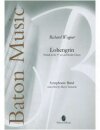| Besetzung: | Blasorchester |
| Komponist: | Edward William Elgar |
| Arrangeur: | Diana Mols |
| Grad:Schwierigkeitsgrad: | 5 (sehr schwer / Höchststufe) |
| Genre: | Ouvertüre , Klassik |
| Dauer: | 15:00 |
| Stimmen:Enthaltene Stimmen: |
|
| Format: | DIN A4 |
| Verlag: | Star Music Publishing |
| Kategorie: | Ouvertüren |
Cockaigne (In London Town), Op. 40, also known as the Cockaigne Overture, is a concert overture for full orchestra composed by the British composer Edward Elgar in 1900-01. In its 15 minutes or so the overture gives a lively and colourful musical portrait of Edwardian London. Cockaigne was a term used by moralists at that time as a metaphor for gluttony and drunkenness, while Britain adopted the name humorously for London. There is no narrative programme, but the work presents various aspects of turn-of-the-century London and Londoners. It begins with a quiet but bustling theme which leads into an unbroken sequence of snapshots: the cockneys, the church bells, the romantic couples, a slightly ragged brass band (perhaps the Salvation Army) and a contrastingly grand and imperious military band.
The broad theme representing Londoners is, Michael Kennedy states, the first occurrence of Elgars trademark direction, nobilmente. The work ends in a characteristically Elgarian blaze of orchestral sound. Mindful, perhaps, of the way Elgar brings his themes together at the climax of the piece, both Bernard Shaw and W.H. "Billy" Reed compared the work to Richard Wagner's Die Meistersinger von Nürnberg Prelude, which culminates in the combination of several themes.
Shaw, in a long article on Elgar in 1920, wrote: "But if you say that Elgars Cockaigne overture combines every classic quality of a concert overture with every lyrical and dramatic quality of the overture to Die Meistersinger, you are either uttering a platitude as safe as a compliment to Handel on the majesty of the "Hallelujah" Chorus, or else damning yourself to all critical posterity by uttering a gaffe that will make your grandson blush for you. Personally, I am prepared to take the risk. What do I care for my grandson? Give me Cockaigne." Reed wrote: "The Cockaigne Overture does not eclipse the Mastersingers prelude, but neither is it outshone by Wagners most symphonically satisfying introductory composition from which it actually borrows some procedures. Elgar's piece is as splendidly evocative a picture of Edwardian London as Wagners is of medieval Nuremberg, and there is nothing to choose between the two in humour, mastery of construction and appositeness of scoring."












